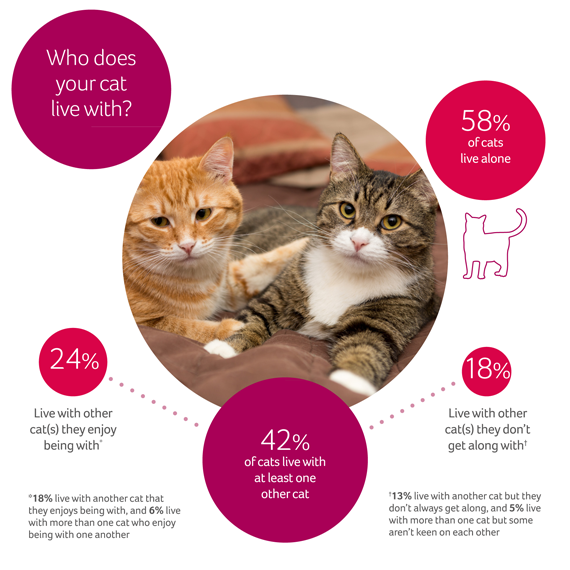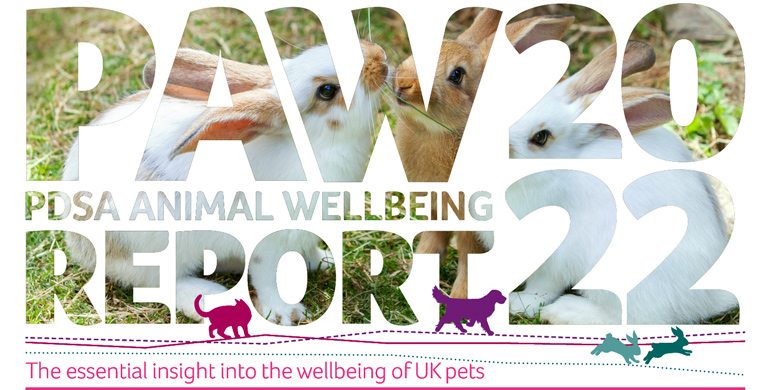Companionship
It is important that owners provide for the different companionship needs of their pets. Dogs’ and cats’ companionship needs can often be met by humans26, but rabbits need the company of other rabbits27. 85% of owners felt informed about their pet’s companionship needs. Significantly fewer cat owners feel very well informed about companionship (33%) compared to rabbit owners (46%) and dog owners (42%).
How long were dogs left alone?
Not surprisingly, our August 2020 survey, conducted after the first UK lockdown in response to the COVID-19 pandemic, found that owners were spending more time with their dogs. At that time, 43% of owners told us that their dog was not left alone on a typical day, and only 11% said that their dog was left alone for 5 hours or more.
In 2022, the amount of time that dogs are left alone for is beginning to return to pre-pandemic levels, with 32% of owners saying that on a typical day, their dogs were not left alone, and 15% were left for 5 hours or more hours, equating to 1.5 million dogs. Owners who had acquired their dog since the beginning of the pandemic were no more likely to leave their pet alone for 5 hours or more (14%) compared to those who had owned for 3-5 years (17%) or over 5 years (15%). Owners who not registered with a vet (22%) were more likely to leave their dogs at home for 5 or more hours compared to those who were registered with a vet (14%), which may reflect a better awareness of their dog’s companionship needs, following discussions with a veterinary professional.

Cats
42% of cats in the UK live with another cat including 18% who live with another cat who they don’t get on with, or where some aren’t keen on each other, which could mean that 2 million cats are living under stressful living conditions. It is possible that this is under-reported, as owners may not always recognise when their cats are not getting on together.
In multi-cat households, younger cats are more likely to get on with other cats they live with; more cats aged 1 – 5 years (63%) live with other cats that they enjoy living with compared to cats aged 16 years or more (42%). This may be related to being accustomed to other cats from a younger age or not being socially mature yet. These findings suggest that, at least in the eyes of their owners, male cats are also more likely to get on with other cats that they live with – in multi-cat households, 61% of male cats live with other cats they enjoy being with compared to 51% of female cats.
65% of cat owners living on their own had one cat compared to 57% of owners living in a household of 2 people and 57% living in a household of 3-4 people.

Rabbits
The proportion of rabbits living alone (46%) is now no different compared to immediately prior to the pandemic (42% in February 2020) which is reassuring given that the 2021 figure (48%) was higher than February 2020. However, this still means that over 460,000 rabbits are living a lonely existence without the companionship their highly social species requires.
The proportion of rabbits living with at least one other rabbit is down from 47% in February 2020 to 41% in 2022. As the proportion of rabbits living completely alone hasn’t increased, it might be that slightly more owners are keeping their rabbit with another species (e.g. guinea pig), but these changes are not visible in the data as yet.
59% of rabbits owned for 5 years or more live alone, compared to 38% of those owned for up to 2 years and 45% of those owned for 3-5 years. Senior rabbits (55%, aged 5 years and older) are more likely to be kept alone compared to adult rabbits (41%, aged 2-4 years old) or junior rabbits (33%, aged up to 1 year old).
This supports last year’s finding that the most common reason for only having one rabbit (34%) was that owners had had more than one rabbit but one had passed away and they chose not to replace them.


Footnotes
26. Bradshaw, J. W. (2016). Sociality in cats: A comparative review. Journal of veterinary behavior, 11, 113-124
27. DiVincenti Jr, L., & Rehrig, A. N. (2016). The social nature of European rabbits (Oryctolagus cuniculus). Journal of the American Association for Laboratory Animal Science, 55(6), 729-736.

